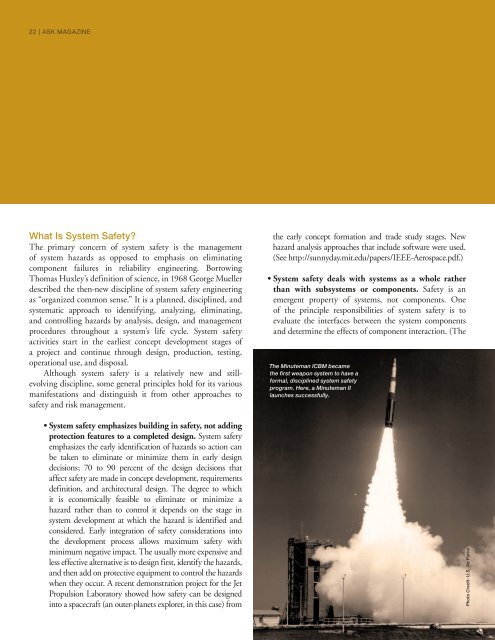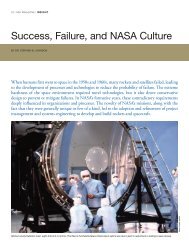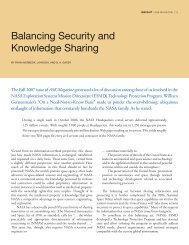An Introduction to System Safety - NASA ASK Magazine
An Introduction to System Safety - NASA ASK Magazine
An Introduction to System Safety - NASA ASK Magazine
Create successful ePaper yourself
Turn your PDF publications into a flip-book with our unique Google optimized e-Paper software.
22 | <strong>ASK</strong> MAGAZINE<br />
What Is <strong>System</strong> <strong>Safety</strong>?<br />
The primary concern of system safety is the management<br />
of system hazards as opposed <strong>to</strong> emphasis on eliminating<br />
component failures in reliability engineering. Borrowing<br />
Thomas Huxley’s definition of science, in 1968 George Mueller<br />
described the then-new discipline of system safety engineering<br />
as “organized common sense.” It is a planned, disciplined, and<br />
systematic approach <strong>to</strong> identifying, analyzing, eliminating,<br />
and controlling hazards by analysis, design, and management<br />
procedures throughout a system’s life cycle. <strong>System</strong> safety<br />
activities start in the earliest concept development stages of<br />
a project and continue through design, production, testing,<br />
operational use, and disposal.<br />
Although system safety is a relatively new and stillevolving<br />
discipline, some general principles hold for its various<br />
manifestations and distinguish it from other approaches <strong>to</strong><br />
safety and risk management.<br />
• <strong>System</strong> safety emphasizes building in safety, not adding<br />
protection features <strong>to</strong> a completed design. <strong>System</strong> safety<br />
emphasizes the early identification of hazards so action can<br />
be taken <strong>to</strong> eliminate or minimize them in early design<br />
decisions; 70 <strong>to</strong> 90 percent of the design decisions that<br />
affect safety are made in concept development, requirements<br />
definition, and architectural design. The degree <strong>to</strong> which<br />
it is economically feasible <strong>to</strong> eliminate or minimize a<br />
hazard rather than <strong>to</strong> control it depends on the stage in<br />
system development at which the hazard is identified and<br />
considered. Early integration of safety considerations in<strong>to</strong><br />
the development process allows maximum safety with<br />
minimum negative impact. The usually more expensive and<br />
less effective alternative is <strong>to</strong> design first, identify the hazards,<br />
and then add on protective equipment <strong>to</strong> control the hazards<br />
when they occur. A recent demonstration project for the Jet<br />
Propulsion Labora<strong>to</strong>ry showed how safety can be designed<br />
in<strong>to</strong> a spacecraft (an outer-planets explorer, in this case) from<br />
the early concept formation and trade study stages. New<br />
hazard analysis approaches that include software were used.<br />
(See http://sunnyday.mit.edu/papers/IEEE-Aerospace.pdf.)<br />
• <strong>System</strong> safety deals with systems as a whole rather<br />
than with subsystems or components. <strong>Safety</strong> is an<br />
emergent property of systems, not components. One<br />
of the principle responsibilities of system safety is <strong>to</strong><br />
evaluate the interfaces between the system components<br />
and determine the effects of component interaction. (The<br />
The Minuteman ICBM became<br />
the first weapon system <strong>to</strong> have a<br />
formal, disciplined system safety<br />
program. Here, a Minuteman II<br />
launches successfully.<br />
Pho<strong>to</strong> Credit: U.S. Air Force




